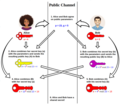Quantum key distribution (QKD) is a secure communication method that implements a cryptographic protocol involving components of quantum mechanics. It...
103 KB (11,878 words) - 13:53, 13 May 2025
Quantum key distribution (QKD) protocols are used in quantum key distribution. The first protocol of that kind was BB84, introduced in 1984 by Charles...
5 KB (720 words) - 06:35, 18 August 2024
demonstration of BB84 quantum key distribution in optical aircraft downlinks. Airborne demonstration of a quantum key distribution receiver payload. Communication...
12 KB (1,378 words) - 17:16, 20 April 2025
require only very modest quantum processors. For most quantum internet protocols, such as quantum key distribution in quantum cryptography, it is sufficient...
55 KB (6,389 words) - 19:00, 18 May 2025
cryptography is quantum key distribution, which offers an information-theoretically secure solution to the key exchange problem. The advantage of quantum cryptography...
81 KB (9,073 words) - 05:33, 17 April 2025
applications of quantum cryptography is quantum key distribution which provide a theoretical solution to the security issue of a classical key. The advantage...
42 KB (4,547 words) - 19:03, 10 January 2025
European receiving stations. The satellite conducted Space-Earth quantum key distribution (Chinese: 量子密钥分发) experiments, facilitated by laser communications...
23 KB (1,942 words) - 14:20, 5 March 2025
The DARPA Quantum Network (2002–2007) was the world's first quantum key distribution (QKD) network, operating 10 optical nodes across Boston and Cambridge...
10 KB (1,261 words) - 13:54, 25 April 2024
Decoy state (category Quantum cryptography)
Within quantum cryptography, the Decoy state quantum key distribution (QKD) protocol is the most widely implemented QKD scheme. Practical QKD systems use...
11 KB (1,348 words) - 22:38, 24 July 2023
October 8, 2008 SECOQC was launched in Vienna. Quantum cryptography, usually known as quantum key distribution (QKD) provides powerful security. But it has...
3 KB (354 words) - 17:14, 29 January 2024
They run quantum key distribution through both optical PUFs; with a slight modification of the protocol, they get quantum key distribution and two-way...
10 KB (1,431 words) - 05:21, 6 October 2023
applications of quantum cloning is to analyse the security of quantum key distribution protocols. Teleportation, nuclear magnetic resonance, quantum amplification...
23 KB (3,063 words) - 10:58, 25 October 2024
later influenced the development of quantum key distribution protocols used in quantum cryptography. Wiesner's quantum money scheme was first published in...
4 KB (534 words) - 19:20, 16 April 2025
problems include quantum key distribution, randomness expansion, and randomness amplification. The goal of quantum key distribution is for two parties...
8 KB (907 words) - 20:22, 31 March 2025
applied quantum theory to cryptography protocols and demonstrated that quantum key distribution could enhance information security. Quantum algorithms...
113 KB (12,419 words) - 13:17, 14 May 2025
One-time pad (redirect from One time key)
equals the size of the pad. Quantum key distribution also proposes a solution to this problem, assuming fault-tolerant quantum computers. Distributing very...
55 KB (7,403 words) - 01:02, 10 April 2025
to do. Most modern symmetric-key algorithms appear to be resistant to the threat of post-quantum cryptography. Quantum computers would exponentially...
15 KB (1,540 words) - 19:12, 22 April 2025
quantum Diffie-Hellman key-exchange protocol that relies on a quantum one-way function, and its security relies on fundamental principles of quantum mechanics...
48 KB (5,437 words) - 16:48, 22 April 2025
In quantum computing, quantum supremacy or quantum advantage is the goal of demonstrating that a programmable quantum computer can solve a problem that...
54 KB (5,929 words) - 02:59, 7 April 2025
Thomas Jennewein (category Quantum physicists)
is an Austrian physicist who conducts research in quantum communication and quantum key distribution. He has taught as an associate professor at the University...
11 KB (1,076 words) - 04:03, 28 April 2025
In physics, in the area of quantum information theory and quantum computation, quantum steering is a special kind of nonlocal correlation, which is intermediate...
6 KB (981 words) - 13:26, 22 April 2025
public-key algorithms) that are currently thought to be secure against a cryptanalytic attack by a quantum computer. Most widely-used public-key algorithms...
63 KB (6,408 words) - 13:56, 6 May 2025
High-dimensional quantum key distribution (HDQKD) is a technology for secure communication between two parties. It allows for higher information efficiency...
2 KB (230 words) - 08:07, 18 March 2025
development of quantum computing, quantum communication and quantum sensing. Quantum computing and communication are two sub-fields of quantum information...
48 KB (2,047 words) - 11:04, 8 May 2025
BB84 (category Quantum information science)
BB84 is a quantum key distribution scheme developed by Charles Bennett and Gilles Brassard in 1984. It is the first quantum cryptography protocol. The...
9 KB (1,111 words) - 08:04, 18 March 2025
establish a multi-node quantum network to implement inter-city quantum key distribution(QKD) for covering distances of over 2,000 kilometres. There is...
23 KB (2,579 words) - 04:23, 29 April 2025
protocols, e.g. Quantum Byzantine agreement. Unlike other types of quantum cryptography (in particular, quantum key distribution), quantum coin flipping...
24 KB (3,294 words) - 04:26, 7 November 2024
student, where he worked in the field of Quantum Cryptography and specialized in the Security of Quantum Key Distribution, which became the title of his doctoral...
5 KB (448 words) - 06:16, 6 May 2024
Noisy-storage model (category Quantum cryptography)
information about the long key. This is known as quantum key distribution (QKD). Yet, it has been shown that even quantum communication does not allow...
22 KB (2,870 words) - 00:14, 25 December 2024
Squeezed states of light (category Quantum states)
state, EPR correlations exist, see Fig. 5. The aim of quantum key distribution is the distribution of identical, true random numbers to two distant parties...
46 KB (6,180 words) - 03:33, 26 April 2025









